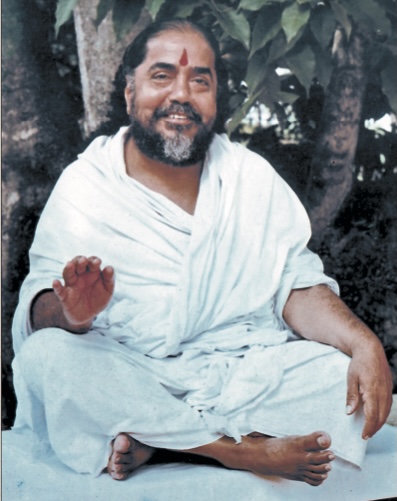BY H. H. SRI SRI TIRUCHI MAHASWAMIGAL
Ever since man appeared on earth, ever since he sought the welfare of himself and his fellow beings, man has been striving to build temples, ashrams, meditation halls and spiritual centers, etc. Although all religions have worship centers, Hinduism has the most ancient and most elaborate form of temple worship. In the Hindu temple the omnipresent Paramatma (Supreme Soul, God) reveals Him, Her or Itself in a confined but supernormal form perceived by devotees in various ways as Siva, Rajarajeshwari, Vishnu and so on. Here the omnipresent, silent, apparently inactive Paramatma becomes active, like Surya (the sun) which generally does not manifest as fire on Earth but does so when focused through a lens. The various rituals employed in consecrating the temple and the Deity therein collectively direct the sunlight of the Paramatma through the lens. The Sanskrit word for temple is alayam. A means jivatma (the individual soul), and layam means merging. Hence, alayam is a place where the jivatma merges with the Paramatma (Supreme Soul).
This universe is the playground of the Divine. Living beings are His playmates, and inanimate creations are His toys. This is a Divine play (lila). The Divine neither loses nor wins. He is only a silent cause and observer of His own game. The winners are His devotees and the losers are the non-devotees. The most loving, eternal relationship is between the jivatma (individual soul) and Paramatma (the Divine, unconditioned, ultimate reality.) The simplest way of keeping this relationship fresh, alive and rich is submissive worship. While silent personal worship keeps the individual in constant communion with the Divine, communal or mass worship brings the welfare of mankind and all living beings at large.
Devotion, bhakti, is of two kinds. The first is apara or gauna bhakti (subordinate devotion with qualities.) Meditation, ritual temple worship, repetition of a sacred mantra, congregational singing of the names of God, are gauna bhakti. The second is para bhakti (transcendent devotion), the mature state of devotion of jnanis (realized souls) and sannyasis (renunciates), where they see everything in a state of bliss. Para bhakti liberates the soul from worldly bondage. But realized souls and sannyasis do advocate and themselves also practice apara bhakti, the worship of form.
Both saints and common people are benefitted by temple worship. The common man generally thinks only of his own pleasure, happiness or welfare, or at most, the welfare of his blood relations. He thus conditions himself against the joy of constant Divine communion achieved by transcendent devotion. But he can find that communion when visiting a temple. Devotional service such as cleaning the temple purifies the body. Japa (repetition of a mantra) clarifies the intellect and absolves sins. Ritual Deity worship bestows merit. Meditation fosters knowledge. The fire ceremony leads to prosperity. Regular festivals involving all the above directly promote reliable monsoon rains, thereby good crops and the well-being of all living beings. All types of art flourish in temples. Scriptural lore, painting, sculpture, dance and music find wide application in temples. Music fosters stability of the mind. The temple bell resonates “Aum,” the sacred sound, assisting saints in formless worship while imparting knowledge of music to ordinary people. The piercing nadaswaram wind instrument awakens awareness of the soul as separate and different from the body.
The nadaswaram, conch, cymbals, flute and music represent the five elements: earth, water, fire, air and ether. So also do sandalwood paste, holy water, ornaments, incense and chanting. All five are united in the stone image. Among temple images, those made of crystal are very auspicious, for the crystal conceals its own form and reveals the forms of others associated with it. It is noteworthy that all the features of an ideal Siva temple have been meticulously incorporated in Kauai’s Iraivan Temple plan.
We have been associated with the Iraivan Temple right from its inception. Satguru Sri Sivaya Subramuniyaswami’s dedicated intention to build an all-stone temple at Kauai is wholly in accordance with the Hindu ideology of selfless Divine action for the welfare of mankind. Another noteworthy aspect of temple worship is the antiquity of the place at which the temple emerges. All major pilgrimage centers are invariably ancient shrines or rivers or both. Having visited Kauai myself, I can say that the island exhibits all the features of a punya kshetra, a sacred meritorious pilgrimage center, namely, sthala– sacred place, murti (an ancient crystal Sivalinga) and tirtha–the Wailua river and the abode of a saint of very high order. The natural vegetation, the devotional fervor and the modes of worship of the native Hawaiians point to an ancient bond with spiritual India. This spiritually hidden sacred place has been discovered by Satguru Sivaya Subramuniyaswami providentially. The Iraivan Temple at Kauai will be to America what the temples of Chidambaram, Madurai, Rameshwaram and other jyotir-lingas (light centers of Siva) are to India. Our scriptures enjoin pilgrimage as a life imperative for a devout Hindu to be absolved of all past karmas. We feel that this scriptural injunction of pilgrimage will take on great meaning, not only for American Hindus, but for Hindus all over the world at large, after they pilgrimage to the Iraivan Temple at Kauai.
